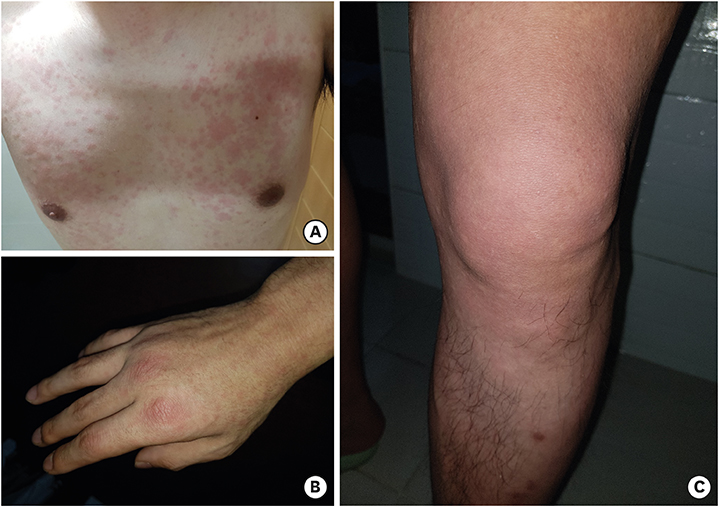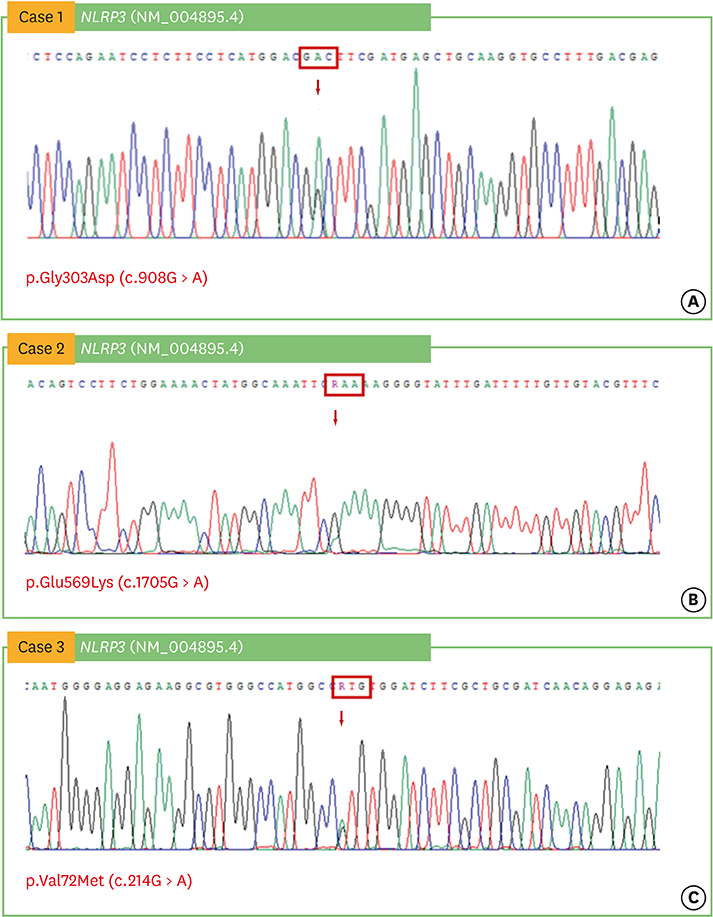Allergy Asthma Immunol Res.
2019 Jul;11(4):583-588. 10.4168/aair.2019.11.4.583.
The First Case Series of Cryopyrin-Associated Periodic Syndrome in Korea
- Affiliations
-
- 1Department of Internal Medicine, Gangnam Severance Hospital, Yonsei University College of Medicine, Seoul, Korea. craft7820@yuhs.ac
- 2Department of Pediatrics, Severance Children's Hospital, Yonsei University College of Medicine, Seoul, Korea.
- 3Division of Clinical Genetics, Department of Pediatrics, Yonsei University College of Medicine, Seoul, Korea.
- 4Division of Allergy and Immunology, Department of Internal Medicine, Yonsei University College of Medicine, Seoul, Korea.
- KMID: 2448760
- DOI: http://doi.org/10.4168/aair.2019.11.4.583
Abstract
- Cryopyrin-associated periodic syndrome (CAPS) is a hereditary autoinflammatory syndrome caused by mutations in NLRP3 (encoding cryopyrin), which presents with fever, fatigue and arthralgia. Thus far, however there have been no reports of CAPS in Korea. Herein, we report 3 cases of CAPS for the first time in Korea. The first case, a 28-year-old man with recurrent urticaria, arthralgia and fever induced by cold, all of which were observed in his father, showed elevated erythrocyte sedimentation rate and C-reactive protein. He exhibited a p.Gly303Asp variant of the NLPR3 gene. The second case, a 2-year-old girl who had recurrent urticaria, arthritis and oral and genital ulcers, was positive for HLA B51 and a p.Glu569Lys mutation in exon 3 of the NLRP3 gene. Administration of anakinra greatly improved her symptoms. The third case, a 4-year-old boy who presented with recurrent urticaria, arthralgia, and fever, exhibited a p.Val72Met mutation in exon 1 of the NLRP3 gene. Administration of tocilizumab improved all of his symptoms. This small case series suggests that clinicians consider CAPS and conduct genetic studies when arthralgia and fever are accompanied by urticaria in Korea.
Keyword
MeSH Terms
Figure
Reference
-
1. Hoffman HM, Mueller JL, Broide DH, Wanderer AA, Kolodner RD. Mutation of a new gene encoding a putative pyrin-like protein causes familial cold autoinflammatory syndrome and Muckle-Wells syndrome. Nat Genet. 2001; 29:301–305.
Article2. Cuisset L, Jeru I, Dumont B, Fabre A, Cochet E, Le Bozec J, et al. Mutations in the autoinflammatory cryopyrin-associated periodic syndrome gene: epidemiological study and lessons from eight years of genetic analysis in France. Ann Rheum Dis. 2011; 70:495–499.
Article3. Houx L, Hachulla E, Kone-Paut I, Quartier P, Touitou I, Guennoc X, et al. Musculoskeletal symptoms in patients with cryopyrin-associated periodic syndromes: a large database study. Arthritis Rheumatol. 2015; 67:3027–3036.4. Jéru I, Hayrapetyan H, Duquesnoy P, Sarkisian T, Amselem S. PYPAF1 nonsense mutation in a patient with an unusual autoinflammatory syndrome: role of PYPAF1 in inflammation. Arthritis Rheum. 2006; 54:508–514.
Article5. Kuemmerle-Deschner JB, Ozen S, Tyrrell PN, Kone-Paut I, Goldbach-Mansky R, Lachmann H, et al. Diagnostic criteria for cryopyrin-associated periodic syndrome (CAPS). Ann Rheum Dis. 2017; 76:942–947.
Article6. Hoffman HM, Wanderer AA, Broide DH. Familial cold autoinflammatory syndrome: phenotype and genotype of an autosomal dominant periodic fever. J Allergy Clin Immunol. 2001; 108:615–620.
Article7. Muckle TJ, Wellsm . Urticaria, deafness, and amyloidosis: a new heredo-familial syndrome. Q J Med. 1962; 31:235–248.8. Prieur AM, Griscelli C. Arthropathy with rash, chronic meningitis, eye lesions, and mental retardation. J Pediatr. 1981; 99:79–83.
Article9. Lachmann HJ, Quartier P, So A, Hawkins PN. The emerging role of interleukin-1β in autoinflammatory diseases. Arthritis Rheum. 2011; 63:314–324.
Article10. Hawkins PN, Lachmann HJ, McDermott MF. Interleukin-1-receptor antagonist in the Muckle-Wells syndrome. N Engl J Med. 2003; 348:2583–2584.
Article11. Sibley CH, Plass N, Snow J, Wiggs EA, Brewer CC, King KA, et al. Sustained response and prevention of damage progression in patients with neonatal-onset multisystem inflammatory disease treated with anakinra: a cohort study to determine three- and five-year outcomes. Arthritis Rheum. 2012; 64:2375–2386.
Article12. Lachmann HJ, Kone-Paut I, Kuemmerle-Deschner JB, Leslie KS, Hachulla E, Quartier P, et al. Use of canakinumab in the cryopyrin-associated periodic syndrome. N Engl J Med. 2009; 360:2416–2425.
Article13. Dinarello CA. Biologic basis for interleukin-1 in disease. Blood. 1996; 87:2095–2147.
Article14. Yokota S, Kikuchi M, Nozawa T, Kanetaka T, Sato T, Yamazaki K, et al. Pathogenesis of systemic inflammatory diseases in childhood: “Lessons from clinical trials of anti-cytokine monoclonal antibodies for Kawasaki disease, systemic onset juvenile idiopathic arthritis, and cryopyrin-associated periodic fever syndrome”. Mod Rheumatol. 2015; 25:1–10.
Article15. Aoyama K, Amano H, Takaoka Y, Nishikomori R, Ishikawa O. Cryopyrin-associated periodic syndrome: a case report and review of the Japanese literature. Acta Derm Venereol. 2012; 92:395–398.
Article16. Yokota S, Imagawa T, Nishikomori R, Takada H, Abrams K, Lheritier K, et al. Long-term safety and efficacy of canakinumab in cryopyrin-associated periodic syndrome: results from an open-label, phase III pivotal study in Japanese patients. Clin Exp Rheumatol. 2017; 35:Suppl 108. 19–26.17. Ahn MJ, Yu JE, Jeong J, Sim DW, Koh YI. A case of Schnitzler's syndrome without monoclonal gammopathy-associated chronic urticaria treated with anakinra. Yonsei Med J. 2018; 59:154–157.
Article
- Full Text Links
- Actions
-
Cited
- CITED
-
- Close
- Share
- Similar articles
-
- The First Report on Clinical Manifestation of Cryopyrin-Associated Periodic Syndrome in Korean Children
- A Rare Case of Acute Ocular Hypertensive Episode in a Patient with Chronic Infantile Neurological Cutaneous Articular Syndrome
- A case of PFAPA (periodic fever, aphthous stomatitis, pharyngitis, cervical adenitis) syndrome
- Dental Treatment in a Patient with CINCA Syndrome under General Anesthesia
- A Case Report of Glomus Tumor of the Nasal Columella



